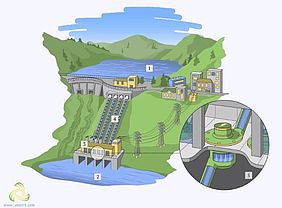The key problem holding back the development of renewable energy is the continuous operation of solar and wind power plants, due to the natural characteristics of these resources. Currently, the most promising trend for ensuring continuous generation of electricity by stations of this type is the use of various types of batteries for storing accumulated energy in the form of pumped storage stations, thermal storage systems for molten salts and electrochemical batteries, mainly using lithium. Thermal storage systems are used as part of plants with solar energy concentrators; however, their level of distribution is incomparable with photovoltaic plants or wind farms. Storing large amounts of energy by means of electrochemical batteries still remains challenging. Therefore, in modern practice, in more than 95% of cases, energy storage is carried out via pumped storage stations. These facilities have a number of excellent characteristics - high reliability, quick response to management commands, and the ability to store large amounts of energy. There are currently over 160 GW installed pumped storage capacities in the world. The leaders in this area are Japan, China and the USA. On average, more than 3 GW of new pumped storage capacities are added annually in the world. At the same time, the annual increase in new capacities in photovoltaics is about 100 GW and more than 50 GW in wind energy: it is clear that the existing scale of renewable electricity production and storage capacity is highly disproportionate. The reason for this lies in the high cost of pumped storage, the lack of accessible natural sites suitable for the construction of a storage station, especially close to real consumers, and serious administrative barriers. In turn, the lack of detailed studies of natural landscapes for their potential use for the construction of pumped storage complicates the further development of the industry.
Researchers at the Australian National University School of Electrical Engineering, Energy and Materials Science have attempted to change this situation. They carried out special studies and identified 530,000 sites in the world potentially suitable for the construction of pumped storage stations1. All identified areas have a high potential for energy storage from small 2 GWh to very large 150 GWh; also, national park land and cities were not taken into account.
In the course of their research the authors relied on specially developed advanced geographic information system (GIS) algorithms. In the study, each identified section contains a pair of reservoirs (upper and lower), a hypothetical tunnel route between the reservoirs, head and volume of water, geographic coordinates of objects and other necessary engineering characteristics.
The authors also emphasize that the substantive application of the research results requires detailed due diligence involving land ownership, engineering, hydrological, environmental and other considerations.
However, the study named the potential storage capacity for the identified areas as 22 million GWh. This large amount of potential storage capacity is many times greater than the total storage needs. If we also take into account the large number of identified areas and the variety of their possible capacities, then the high significance of the obtained data becomes obvious, which in the future can significantly affect the existing realities of the energy market.
1ANU finds 530,000 potential pumped-hydro sites worldwide / April 1, 2019 / The Australian National University / anu.prezly.com/ https://www.anu.edu.au/news/all-news/anu-finds-530000-potential-pumped-hydro-sites-worldwide
